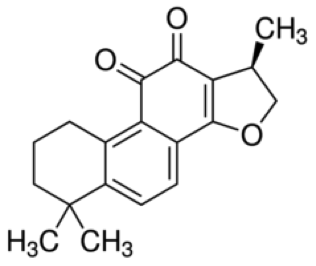
Cryptotanshinone is abbreviated as CPT and is a natural compound isolated from the root of the Asian medicinal plant and Salvia miotiorrhiza bunge. The chemical molecular formula is C19H20O3 and soluble in DMSO to 10 mM. Cryptotanshinone is STAT3 inhibitor with diverse biological activities.
Scientists at Creative Proteomics utilize a highly quantitative method with high-performance liquid chromatography (HPLC) for the determination of Cryptotanshinone levels in various samples, including Plant Tissue and more. High-Performance Liquid Chromatography (HPLC) with UV detection is used for the determination of Cryptotanshinone (270 nm) levels in a lot of biological samples. This Methodology provides accurate, reliable, and reproducible results of Cryptotanshinone measurement, which enables us to analyze of Cryptotanshinone levels in vitro and in vivo.
Cryptotanshinone is reported as an inhibitor against STAT3 and the IC50 is about 4.6 μM in a cell-free assay. Cryptotanshinone can inhibitor the Tyr phosphorylation of STAT3 at the position 705 by a JAK2-independent mechanism, but with a a small effect on the Ser727. Cryptotanshinone can bind to the monomer STAT3 and then the dimerization of STAT3 resulting in inhibiting STAT3 transcriptional regulatory activity in the STAT3-activated cell lines. There are also research paper have suggested that Cryptotanshinone can inhibit the activity of cyclooxygenase II and the expression of endothelin-1 subsequently counteracts inflammation. The dried roots of Salvia Miltiorrhiza Bunge have been used for the treatment of circulatory disorders, liver disease, coronary heart disease, hepatitis, and chronic renal failure in the traditional Chinese medicine. Cryptotanshinone is also a potential anticancer agent. Recently, some research results show that Cryptotanshinone can inhibit the expression of cyclin D1 and the phosphorylation of retinoblastoma (Rb) protein resulting in inhibit cancer cell proliferation by arresting cells in G(1)-G(0) phase of the cell cycle.
The Russian-Polish botanist M. Tswett is generally recognized as the first person to establish the principles of chromatography. In a paper he presented in 1906, Tswett described how he filled a glass tube with chalk powder (CaCO3) and, by allowing an ether solution of chlorophyll to flow through the chalk, separated the chlorophyll into layers of different colors. He called this technique “chromatography”. Fundamentally, chromatography is a technique used to separate the components contained in a sample. High Performance Liquid Chromatography (HPLC) is a method able to separate non-volatile, thermally unstable, and polar components separate or in a mixture. HPLC is a type of chromatography that, because of its wide application range and quantitative accuracy, is regarded as an indispensable analytical technique, particularly in the field of organic chemistry. It is also widely used as a preparation technique for the isolation and purification of target components contained in mixtures.
Cryptotanshinone Analysis Service at Creative Proteomics supports your research in Cryptotanshinone Analysis. HPLC Based Analysis Service Platform enable us at Creative Proteomics offers you a state-of-the-art Analysis Service.
Sample Type
Plant Tissue and more
Method
High-Performance Liquid Chromatography (HPLC) with UV detection is used for the determination of Cryptotanshinone (270 nm) levels in a lot of biological samples. This Methodology provides accurate, reliable, and reproducible results of Cryptotanshinone measurement, which enables us to analyze of Cryptotanshinone levels in vitro and in vivo.
Send us your samples, you will get all information that you need!







